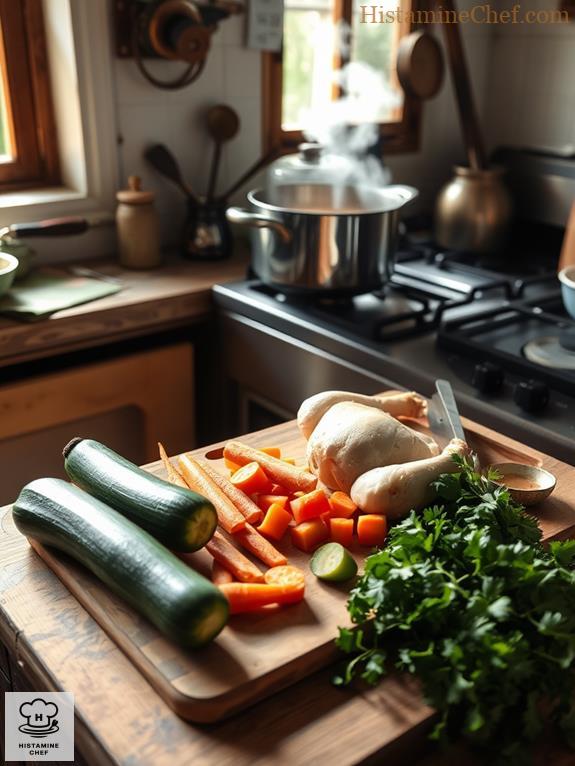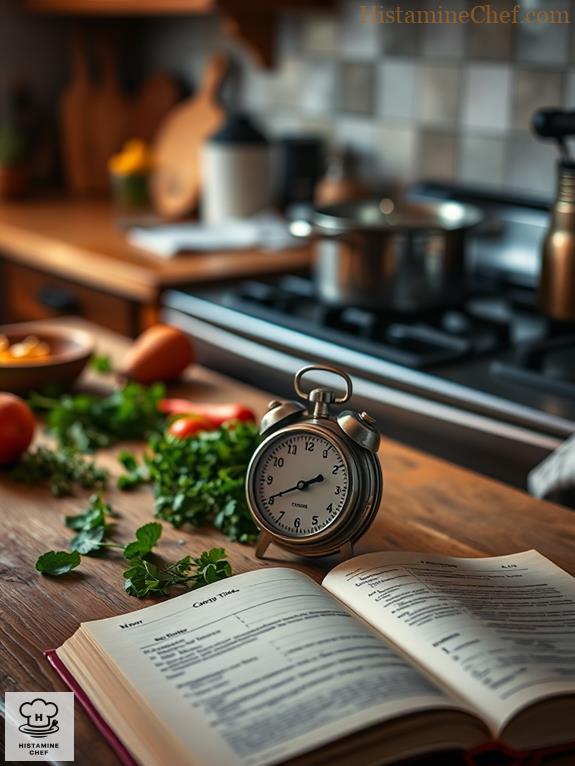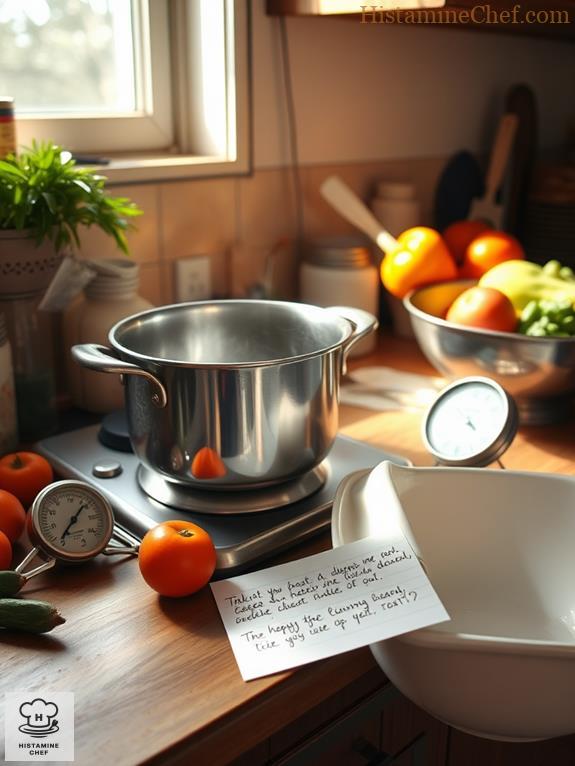Cooking with histamine in mind? It’s a game-changer!
I’ve been there, struggling with reactions. Now, I’m all about fresh, SIGHI-approved ingredients.
Steaming is my go-to. It’s quick, gentle, and keeps those histamine levels low.
I’ve learned that high heat is a no-no. Moderate temps are where it’s at.
Want a flavor boost? I toss in fresh herbs at the end. It’s like magic!
Tweaking cook times has transformed my meals. Who knew it could be this simple?
My Histamine Journey: From Frustration to Flavorful Success
I remember the day my doctor suggested a low-histamine diet. Talk about overwhelmed! I thought, “Goodbye, tasty food.”
But I was so wrong. With some trial and error, I discovered the joy of quick-cooking methods.
Stir-fries became my bestie. I experimented with herbs like basil and cilantro.
Suddenly, my plate was colorful and delicious. It wasn’t just about managing symptoms anymore – I was actually enjoying my food again!
Understanding Histamine Levels

Understanding histamine levels is essential for anyone looking to manage their diet effectively, especially if they’ve histamine intolerance.
Let’s face it, diving into histamine sources can feel like an episode of a cooking game show, right? You’ve got your allowed foods from the SIGHI list—think crisp apples and vibrant quinoa—waiting to be your culinary champions!
Meanwhile, the restricted foods, like aged cheeses and processed meats, are like the villains lurking in the pantry. Histamine-related disorders, such as histaminosis, can be managed more effectively by understanding the histamine content in different foods and ingredients.
By knowing these histamine levels, you can seize control of your meals, creating a delicious and safe dining experience.
Why let histamine intolerance dictate your life when you can master it?
Join me on this flavorful journey. Together, we’ll turn your kitchen into a histamine-friendly haven!
Cooking Techniques for Histamine Reduction

When it comes to histamine reduction in cooking, mastering techniques can make all the difference in your meal preparation.
I’ve discovered that using gentle cooking methods, like steaming or sautéing, helps keep histamine levels low.
Steaming techniques are particularly effective for preserving nutrients while minimizing histamine formation in foods.
Pairing fresh ingredients, such as apples and quinoa, not only enhances flavors but also minimizes histamine spikes.
Ever tried baking with fresh herbs? It’s a game-changer!
And don’t forget about proper food storage—keeping your veggies cool and away from light can help maintain their freshness and histamine levels.
So, why not experiment with these techniques in your kitchen?
Each meal can be both delicious and histamine-conscious.
That’s why I write this blog, Histamine Chef, to empower you to enjoy food without fear!
Modifying Cooking Times

When it comes to histamine-conscious cooking, tweaking cooking times can make a big difference!
I’ve found that adjusting cooking temperatures and timing for ingredient additions can be the secret sauce to keeping my meals delicious and low in histamine.
Pressure cooking is another excellent method for reducing histamine levels in foods, as it markedly shortens cooking times while maintaining flavor and nutrients.
Have you ever thought about how just a few extra minutes in the pot can change everything?
Adjusting Cooking Temperatures
Cooking at the right temperature is essential for histamine-conscious meals, as it can considerably affect the histamine levels in your food.
You see, using proper cooking equipment and temperature monitoring can make all the difference! High temperatures can elevate histamine in ingredients, especially in meats and certain vegetables.
So, I always aim for lower heat when cooking my chicken or veggies, ensuring they’re tender without turning into histamine bombs.
Imagine biting into a juicy chicken breast that’s perfectly cooked—delicious, right? But crank up that heat too high, and you might be in for an unwanted surprise!
Timing for Ingredient Additions
Timing is essential for ensuring that each ingredient maintains its quality and histamine levels in a histamine-conscious meal.
When you’re cooking, think about timing considerations for each ingredient. For instance, adding fresh herbs at the end of cooking maximizes their flavor and keeps histamine levels low.
Ever wondered why your soup tastes flat when you throw everything in at once? It’s all about ingredient compatibility!
With veggies, toss in those allowed ones, like carrots and zucchini, toward the end.
And keep in mind, I’m here to help fellow food lovers navigate their histamine journeys!
So next time you cook, don’t forget: timing is everything.
Let’s savor those delicious, low-histamine meals together!
Ingredient Selection for Low Histamine

Finding your way through ingredient selection for a low histamine diet can feel overwhelming, but it’s essential for those sensitive to histamine.
I get it—what’s left to eat, right? Don’t fret! Start exploring ingredient alternatives like fresh fruits such as apples and blueberries, and vegetables like carrots or zucchini. They’re delicious!
When craving that tangy tomato flavor, consider low histamine substitutes that can mimic the taste without triggering reactions.
And let’s talk flavor enhancers. Fresh herbs like basil or thyme can elevate your meals without the histamine hassle.
Remember, the SIGHI list is your trusty guide. It’s like having a map on a treasure hunt!
Embrace this journey, and soon, you’ll whip up meals that aren’t just low histamine but bursting with flavor.
Trust me, it’s worth the effort!
Temperature Control in Cooking

When it comes to cooking, temperature control is key to keeping histamine levels low.
I’ve learned that cooking food at the right temperature not only enhances flavors but also helps keep those pesky histamines in check.
Quick-cooling techniques are essential for minimizing histamine formation after cooking. Using a blast chiller can greatly reduce the time food spends in the temperature danger zone.
Cooking Temperature Guidelines
In cooking, maintaining the right temperature is essential for both flavor and safety, especially for those managing histamine sensitivities.
When using different cooking methods like sautéing or roasting, keep in mind that high heat can speed up ingredient interactions, sometimes releasing histamines you’d rather avoid.
I always keep a close eye on temperatures, aiming for moderate heat to preserve those delicate flavors and nutrients.
Imagine biting into a perfectly cooked chicken breast—juicy and tender—compared to a dry, overcooked one. Yikes, right?
On the other hand, if you’re working with fresh veggies, a quick steam or stir-fry can keep them vibrant and nutritious.
Cooling and Storage Tips
After mastering the right cooking temperatures, the next step involves how to cool and store your dishes properly.
You mightn’t realize it, but cooling methods can make all the difference. Always refrigerate your leftovers within two hours. I often place hot dishes in shallow storage containers to help cool them faster—it’s a game changer!
Remember, the right storage containers are essential. Opt for airtight ones to keep moisture out and prevent any sneaky histamine build-up.
Speaking of histamines, keep your high-histamine foods away from your low-histamine delights—nobody wants a party crasher!
Trust me; when you respect cooling and storage, you empower your body. That’s the essence of what I share here at Histamine Chef.
Reheating Best Practices
How can you guarantee that your reheated meals remain safe and delicious?
First off, choose your reheating methods wisely! Microwaves, stovetops, or ovens can be great, but the key is temperature. Always aim for at least 165°F (74°C) to ascertain safe reheating.
Next, recall to heat evenly. Stirring or flipping your food helps it reach that magical temperature all over.
And don’t forget the SIGHI list! If you’re using allowed ingredients, like fresh chicken or rice, you’re on the right track.
Finally, enjoy the aroma while you wait. There’s nothing like the smell of a warm, cozy meal!
I write this blog, Histamine Chef, to empower your cooking journey—let’s make every bite count!
Meal Prep Strategies

Getting a jump on meal prep can be a game changer, especially when managing a histamine-conscious diet.
I’ve found a few simple strategies that really empower my cooking game!
Effortless meal planning can greatly reduce stress and save time when dealing with histamine sensitivity. Incorporating rapid meal planning techniques guarantees you always have safe, delicious options available.
- Grocery shopping with a focused list saves time and keeps me on track.
- Meal planning lets me mix and match low histamine ingredients.
- Ingredient substitutions can transform a recipe while keeping it safe.
- Portion control guarantees I don’t go overboard—my waistline appreciates it!
- Batch cooking means I’ve meals ready to go, reducing stress.
Don’t overlook food safety and kitchen organization!
Keep in mind, I write this blog, Histamine Chef, to help you navigate the flavorful world of histamine-conscious cooking.
Let’s conquer meal prep together!
Tips for Safe Storage

Safe storage is essential when managing a histamine-conscious diet, as it helps preserve the freshness of allowed foods and prevents the growth of histamine-producing bacteria.
Implementing smart storage techniques can greatly reduce histamine levels in your food, making your meals safer and more enjoyable.
To keep your ingredients at their best, use safe containers and airtight storage.
Trust me, moisture control is your friend! Proper labeling can save you from a mystery meal gone wrong.
I can’t stress enough the importance of a cool environment and temperature monitoring.
You don’t want your fresh veggies turning into a soggy mess!
Rotate your foods regularly to guarantee ingredient freshness and maximize shelf life.
Freezing methods can be a lifesaver for meats and some fruits.
FAQ
How Does Histamine Sensitivity Vary Between Individuals?
I’ve noticed histamine sensitivity varies widely among individuals. Each person’s unique tolerance shapes how they respond to histamine triggers, making it essential to identify personal limits for better health and well-being.
Are There Specific Brands of Low Histamine Foods to Recommend?
When traversing the vast ocean of low histamine foods, I recommend brands like “Safe Eats” and “Histamine Safe.” Product comparisons reveal they’re not just good; they’re essential for maintaining balance in my diet.
Can Cooking Methods Affect Histamine Levels in Food?
I’ve found that cooking techniques can greatly impact histamine levels. For instance, avoiding fermentation processes, like pickling or aging, helps me maintain a low histamine diet. It’s empowering to control what I eat!
What Are the Best Ways to Test Food for Histamine?
When I consider histamine testing, I prioritize lab tests and elimination diets to identify food allergies. Monitoring reactions helps me pinpoint triggers, empowering me to manage my diet effectively and confidently without fear.
How Can I Identify High-Histamine Reactions After Eating?
I track my symptoms diligently in a food diary. Each entry reveals patterns, helping me pinpoint high-histamine reactions. This proactive approach empowers me to manage my diet effectively and enhance my overall well-being.
Summary
I’ve discovered that adjusting cooking times for histamine-conscious recipes isn’t limiting; it’s liberating. By being mindful of heat and duration, I create dishes that are both delicious and gentle on my body. This approach has opened up a world of new flavors and textures.
Have you experimented with cooking times for histamine-conscious meals? Share your experiences in the comments below.
Help spread the word about histamine-friendly cooking by sharing this post on your social media. Your support helps grow the Histamine Chef community and reach more people seeking healthy, delicious recipes.


Leave a Reply